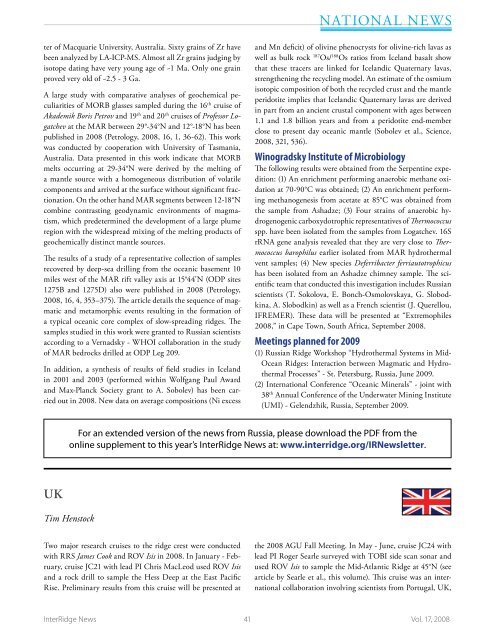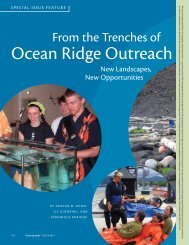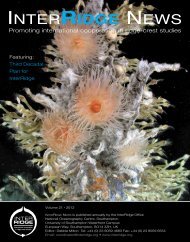Full version, lower resolution, 3.25MB - InterRidge
Full version, lower resolution, 3.25MB - InterRidge
Full version, lower resolution, 3.25MB - InterRidge
Create successful ePaper yourself
Turn your PDF publications into a flip-book with our unique Google optimized e-Paper software.
National News<br />
ter of Macquarie University, Australia. Sixty grains of Zr have<br />
been analyzed by LA-ICP-MS. Almost all Zr grains judging by<br />
isotope dating have very young age of ~1 Ma. Only one grain<br />
proved very old of ~2.5 - 3 Ga.<br />
A large study with comparative analyses of geochemical peculiarities<br />
of MORB glasses sampled during the 16 th cruise of<br />
Akademik Boris Petrov and 19 th and 20 th cruises of Professor Logatchev<br />
at the MAR between 29°-34°N and 12°-18°N has been<br />
published in 2008 (Petrology, 2008, 16, 1, 36-62). This work<br />
was conducted by cooperation with University of Tasmania,<br />
Australia. Data presented in this work indicate that MORB<br />
melts occurring at 29-34°N were derived by the melting of<br />
a mantle source with a homogeneous distribution of volatile<br />
components and arrived at the surface without significant fractionation.<br />
On the other hand MAR segments between 12-18°N<br />
combine contrasting geodynamic environments of magmatism,<br />
which predetermined the development of a large plume<br />
region with the widespread mixing of the melting products of<br />
geochemically distinct mantle sources.<br />
The results of a study of a representative collection of samples<br />
recovered by deep-sea drilling from the oceanic basement 10<br />
miles west of the MAR rift valley axis at 15°44'N (ODP sites<br />
1275B and 1275D) also were published in 2008 (Petrology,<br />
2008, 16, 4, 353–375). The article details the sequence of magmatic<br />
and metamorphic events resulting in the formation of<br />
a typical oceanic core complex of slow-spreading ridges. The<br />
samples studied in this work were granted to Russian scientists<br />
according to a Vernadsky - WHOI collaboration in the study<br />
of MAR bedrocks drilled at ODP Leg 209.<br />
In addition, a synthesis of results of field studies in Iceland<br />
in 2001 and 2003 (performed within Wolfgang Paul Award<br />
and Max-Planck Society grant to A. Sobolev) has been carried<br />
out in 2008. New data on average compositions (Ni excess<br />
and Mn deficit) of olivine phenocrysts for olivine-rich lavas as<br />
well as bulk rock 187 Os/ 188 Os ratios from Iceland basalt show<br />
that these tracers are linked for Icelandic Quaternary lavas,<br />
strengthening the recycling model. An estimate of the osmium<br />
isotopic composition of both the recycled crust and the mantle<br />
peridotite implies that Icelandic Quaternary lavas are derived<br />
in part from an ancient crustal component with ages between<br />
1.1 and 1.8 billion years and from a peridotite end-member<br />
close to present day oceanic mantle (Sobolev et al., Science,<br />
2008, 321, 536).<br />
Winogradsky Institute of Microbiology<br />
The following results were obtained from the Serpentine expedition:<br />
(1) An enrichment performing anaerobic methane oxidation<br />
at 70-90°C was obtained; (2) An enrichment performing<br />
methanogenesis from acetate at 85°C was obtained from<br />
the sample from Ashadze; (3) Four strains of anaerobic hydrogenogenic<br />
carboxydotrophic representatives of Thermococcus<br />
spp. have been isolated from the samples from Logatchev. 16S<br />
rRNA gene analysis revealed that they are very close to Thermococcus<br />
barophilus earlier isolated from MAR hydrothermal<br />
vent samples; (4) New species Deferribacter ferriautotrophicus<br />
has been isolated from an Ashadze chimney sample. The scientific<br />
team that conducted this investigation includes Russian<br />
scientists (T. Sokolova, E. Bonch-Osmolovskaya, G. Slobodkina,<br />
A. Slobodkin) as well as a French scientist (J. Querellou,<br />
IFREMER). These data will be presented at “Extremophiles<br />
2008,” in Cape Town, South Africa, September 2008.<br />
Meetings planned for 2009<br />
(1) Russian Ridge Workshop “Hydrothermal Systems in Mid-<br />
Ocean Ridges: Interaction between Magmatic and Hydrothermal<br />
Processes” - St. Petersburg, Russia, June 2009.<br />
(2) International Conference “Oceanic Minerals” - joint with<br />
38 th Annual Conference of the Underwater Mining Institute<br />
(UMI) - Gelendzhik, Russia, September 2009.<br />
For an extended <strong>version</strong> of the news from Russia, please download the PDF from the<br />
online supplement to this year’s <strong>InterRidge</strong> News at: www.interridge.org/IRNewsletter.<br />
UK<br />
Tim Henstock<br />
Two major research cruises to the ridge crest were conducted<br />
with RRS James Cook and ROV Isis in 2008. In January - February,<br />
cruise JC21 with lead PI Chris MacLeod used ROV Isis<br />
and a rock drill to sample the Hess Deep at the East Pacific<br />
Rise. Preliminary results from this cruise will be presented at<br />
the 2008 AGU Fall Meeting. In May - June, cruise JC24 with<br />
lead PI Roger Searle surveyed with TOBI side scan sonar and<br />
used ROV Isis to sample the Mid-Atlantic Ridge at 45°N (see<br />
article by Searle et al., this volume). This cruise was an international<br />
collaboration involving scientists from Portugal, UK,<br />
<strong>InterRidge</strong> News 41 Vol. 17, 2008
















